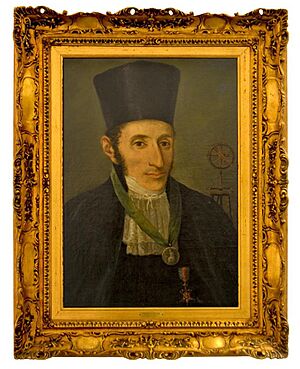Federigo Zuccari facts for kids
Quick facts for kids
Federigo Zuccari
|
|
|---|---|

Oil painting of Federigo Zuccari
|
|
| Born | 26 August 1783 Isola di Sora, Terra di Lavoro, Italy
|
| Died | 15 December 1817 (aged 34) |
| Nationality | Italian |
| Known for | founder of the Astronomical Observatory of Capodimonte |
| Scientific career | |
| Fields | Astronomy |
| Institutions | Astronomical Observatory of Naples, University of Naples Federico II, Polytechnic-Military Schools |
Federigo Zuccari (born August 26, 1783, died December 15, 1817) was an important Italian astronomer. He taught astronomy at the University of Naples and was the first director of the famous Astronomical Observatory of Naples. He helped build this observatory, which became a key place for studying the stars.
Contents
Becoming an Astronomer
Federigo Zuccari studied in Naples and Rome. He was also very interested in literature and art. In 1807, he became a professor at the Real Scuola della Nunziatella. He taught subjects like how to measure distances on Earth using math.
In 1809, King Joachim Murat sent Zuccari to Milan. He went to the Brera Observatory to learn more about astronomy. There, he studied with a famous astronomer named Barnaba Oriani.
Leading the Observatory
After his training, King Murat sent Zuccari back to Naples in 1811. He was made the director of the old observatory. This observatory was located in an ancient monastery called San Gaudioso.
Zuccari soon realized they needed a better place for the observatory. In 1812, he asked the government to build a new one. He wanted it on Miradois hill, near the Royal Palace of Capodimonte.
Building a New Home for Stars
Federigo Zuccari worked with an architect named Stefano Gasse. Together, they designed a grand new building for the observatory. It was built in the neoclassical style, which means it looked like ancient Greek and Roman buildings.
The first stone for the new observatory was laid on November 4, 1812. Sadly, Zuccari passed away before it was finished. Later, another astronomer, Giuseppe Piazzi, changed some parts of the design. This made the building even more useful for studying the sky.
His Work and Discoveries
Even with the few tools at the old San Gaudioso observatory, Zuccari did important work. He observed the Sun and watched eclipses of the Moon and Sun. He also carefully measured the positions of many stars.
He created a detailed list of these star positions. However, this important list was never published because he died too soon. In 1815, his nephew Ernesto Capocci became his student. Together, they also made observations about the weather.
Recognition and Legacy
Federigo Zuccari was a respected scientist. He was a member of several important groups. These included the Academy of Sciences of Naples and the Pontaniana Academy. He was also made a knight, which was a special honor.
His biggest legacy is founding the Astronomical Observatory of Capodimonte. It became a very important place for astronomy in Italy.

